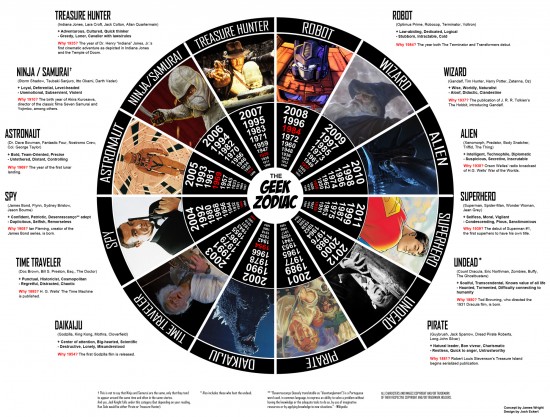Infographic: The Geek Zodiac Calendar
Numerous cultures and religions throughout the span of history have lived their lives based on a zodiac calendar. Established because of the measurable and cyclical movement of the constellations in the sky at different points throughout the year, peoples assign varied names to a rotating number of time periods, either by the year or month. Some are named after animals, others the stars themselves. Now we have a zodiac of our own. Two friends have created The Geek Zodiac, a fun infographic that goes backwards in time and attempts to show the cyclical nature of science fiction, action and fantasy pop culture. But does it really all work out? Find out for yourself after the break.
The Geek Zodiac was conceived by James Wright and designed by his friend Josh Eckert. The final image is from Wright's Tumblr, Words That Fit. Head over there to read about its conception but, for now, click on the image to blow it up.
For an even bigger version, head back to Words That Fit.
And while there's no denying that the Geek Zodiac is an interesting idea and the execution is beautifully done, breaking it down does reveal a few holes, paramount among them is that movies can't be the main focus.
The start dates for each category have specific historical explanations so, even if they're loosely associated, it's hard to argue them.
Looking at things strictly movie related, though, the calendar is full of holes. Calling 2011 the year of the Superhero certainly works. There's Thor, X-Men First Class, Green Lantern and more. But they say the previous year of the superhero was 1999. Of the top fifty highest grossing films of that year, none are legitimate superhero movies. Last year, 2010, is referred to as the year of the Alien. Well, again looking at the top grossing films last year, the most successful "Alien" movie in 2010 was Megamind. On the other hand, the previous year of the Alien, 1998, had Armageddon and Deep Impact, as well as The X-Files and a Star Trek film.
We could go on and on. There are some spot on connections and some real stretches but, either way, you really have to tip your cap to Wright and Eckert for their work.
What are your thoughts on this?

